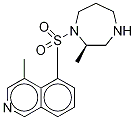871543-07-6
 871543-07-6 結構式
871543-07-6 結構式
基本信息
RHO激酶抑制劑(H-1152 DIHYDROCHLORIDE)
H1152, DIHYDROCHLORIDE
H 1152 DIHYDROCHLORIDE
H1152 DIHYDROCHLORIDE
4-methyl-5-[[(2S)-2-methyl-1,4-diazepan-1-yl]sulfonyl]isoquinoline
5-[[(2S)-Hexahydro-2-Methyl-1H-1,4-diazepin-1-yl]sulfonyl]-4-Methylisoquinoline
H1152P2HCl,(S)-(+)-2-Methyl-1-[(4-methyl-5-isoquinolynyl)sulfonyl]homopiperazineDihydrochloride
H1152P Dihydrochloride, (S)-(+)-2-Methyl-1-[(4-methyl-5-isoquinolynyl)sulfonyl]homopiperazine Dihydrochloride
物理化學性質
| 報價日期 | 產(chǎn)品編號 | 產(chǎn)品名稱 | CAS號 | 包裝 | 價格 |
| 2025/02/08 | HY-15720A | 871543-07-6 H-1152 dihydrochloride | 871543-07-6 | 1 mg | 673元 |
| 2025/02/08 | HY-15720A | 871543-07-6 H-1152 dihydrochloride | 871543-07-6 | 2mg | 950元 |
| 2025/02/08 | HY-15720A | 871543-07-6 H-1152 dihydrochloride | 871543-07-6 | 10mM * 1mLin DMSO | 1554元 |
常見問題列表
|
ROCKII 12 nM (IC 50 ) |
CaMKII 0.18 μM (IC 50 ) |
PKG 0.36 μM (IC 50 ) |
AuroraA 0.745 μM (IC 50 ) |
PKA 3.03 μM (IC 50 ) |
Src 3.06 μM (IC 50 ) |
PKC 5.68 μM (IC 50 ) |
Abl 7.77 μM (IC 50 ) |
MKK4 16.9 μM (IC 50 ) |
MLCK 28.3 μM (IC 50 ) |
EGFR 50 μM (IC 50 ) |
GSK3α 60.7 μM (IC 50 ) |
AMPK 100 μM (IC 50 ) |
P38α 100 μM (IC 50 ) |
H-1152 dihydrochloride is an inhibitor of Rho-kinase, with an IC 50 of 12 nM for ROCK2. H-1152 (H-1152P) also shows less inhibitory activities against CaMKII, PKG, AuroraA, PKA, Src, PKC, MLCK, Abl, EGFR, MKK4, GSK3α, AMPK, and P38α, with IC 50 s of 0.180, 0.360, 0.745, 3.03, 3.06, 5.68, 28.3, 7.77, 50.0, 16.9, 60.7, 100, and 100 μM, respectively. H-1152 potently inhibits Rho kinase, with a K i of 1.6 nM, and slightly suppresses PKA, PKC and MLCK, with K i s of?0.63, 9.27, and 10.1 μM, respectively. H-1152 (0.1-10 μM) highly inhibits MARCKS phosphorylation, with an IC 50 value of 2.5 μM in LPA-treated cells, but shows no such obvious effects in PDBu-treated cells. H-1152 (0.5-10 μM) cuases no decreased neuronal survival. H-1152 (1, 5 or 10 μM) also exerts no alterations in the ratios of different neuronal morphologies. Furthermore, H-1152 (10 μM) increases neurite length in both BMP4 and LIF cultures.